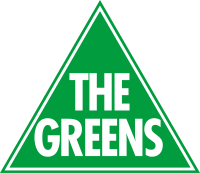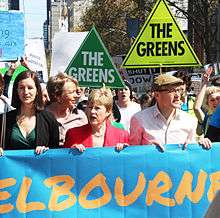Australian Greens Victoria
The Australian Greens – Victoria | |
|---|---|
 | |
| Parliamentary Leader | Greg Barber |
| Convenor | Willisa Hogarth |
| Founded | 1992 |
| Headquarters |
1/362 Little Collins St Melbourne VIC 3001 (GPO Box 4589) |
| Ideology | Green politics |
| International affiliation |
Global Greens Asia-Pacific Green Network |
| Legislative Council |
5 / 40 |
| Legislative Assembly |
2 / 88 |
| Local Government |
29 / 611 |
| Website | |
|
greens | |
Australian Greens Victoria, also called the Victorian Greens, is a Green Party located in Victoria, a member of the federation of the Australian Greens party.
Early years
The Australian Greens - Victoria was formed in 1992, as a response to the formation of the Australian Greens which united pre-existing Green parties in Tasmania, New South Wales, Queensland and the ACT. The first election the Greens contested in Victoria was the 1993 federal election. The party contested the seat of La Trobe.
They first made an impact in 1994 with two outstanding by-election results: 21% in Coburg and 28% in Kooyong. They were among the best results ever achieved by a small party in Australian history.
With greatly increased membership after these successes, the Party tackled the 1996 federal election. Despite Peter Singer as a lead Senate candidate, they achieved only 2.9% of the vote statewide, largely because of a strong Democrats campaign led by Cheryl Kernot. Within a month of the federal election, the Greens took on both many local elections and a general state election.
The Greens had high hopes for their lead Senate candidate at the 1998 federal election. Charmaine Clarke would have been the first Aboriginal woman elected to any parliament in Australia, as well as the first out lesbian elected to Canberra. However, their vote slipped back to 2.5% in an election dominated by One Nation and GST.
1999 Onwards - Greens in Local Government
In March 1999 barrister David Risstrom was elected to the Melbourne City Council, following numerous local government campaigns in Victoria. Risstrom was re-elected in 2001 and retired in 2004 in order to contest the Senate in the Australian national elections of that year. Fraser Brindley, previously elected to Moreland City Council as a Greens representative in 2002, ran successfully for Melbourne City Council in 2004.
The first Greens candidate in Australia to be elected in a single-member electorate was Gurm Sekhon, elected to Yarra City Council in 2001. In 2002 Sekhon was re-elected and three more Greens were elected to Yarra City Council, giving the Greens 4 out of 9 seats on Council. In 2003 Yarra City Councillor Greg Barber became Australia's first Greens Mayor. Janet Rice was elected to Maribyrnong City Council in 2003 with a primary vote of 42%.
In 2005 Janet Rice was re-elected to a second term at Maribyrnong City Council and subsequently became Mayor. David Jones was elected to and became Mayor the City of Greater Bendigo, and a total of 14 Green local government councillors held office across Victoria, in Cities or Shires of Melbourne, Yarra, Maribyrnong, Moreland, Moonee Valley, Yarra Ranges, Whitehorse, Brimbank, Mount Alexander and Greater Bendigo.
In the yearly mayoral elections in 2006, Greater Bendigo Councillors elected back to back Green Mayors by electing Julie Rivendell to succeed David Jones, and Ben Opie was elected as Moonee Valley's first, and Victoria's fifth Green Mayor. In the Mayoral vote for 2007-8 Bendigo elected Cr David Jones again, making him the First Green Mayor to serve two terms and Bendigo to become the first council in Australia to have three Green Mayors.
The 2008 local government elections saw the first elections of Greens Councillors into Darebin, Glen Eira, Manningham, Queenscliffe, Surf Coast and Casey Councils, and saw Samantha Dunn re-elected in a single-member ward in Yarra Ranges with a strong 53% primary vote. Three Green mayors were elected following the elections: Amanda Stone in Yarra, Philip Schier in Mount Alexander, and Helen Harris in Whitehorse. Philip Schier was re-elected in 2009, and Bill Pemberton became Mayor of Whitehorse. Alison Clarke is the 2011 Greens Mayor of the City of Yarra.
State elections
|
Victorian Election Results
|
Three Greens representatives were elected to the Victorian Legislative Council at the 2006 state election. Greg Barber won a seat in the Northern Metropolitan Region, Colleen Hartland won a seat in the Western Metropolitan Region after a recount, and Sue Pennicuik won a seat in the Southern Metropolitan Region.
Minor parties have had little or no success in state lower houses that have single-member electorates, though in other states where there are multiple-member electorates in the lower house (such as Tasmania's or the ACT's), or where there are multiple-member electorate/s in the upper house (such as in NSW, SA and WA), minor parties including the Greens have been more successful. Up to and including the 2002 state election, Victoria's upper house had double-member electorates, though, for the first time in the 2006 state election, Victoria's upper house had 8 electorates of 5 members each.
In the lower house, Greens candidates were second in four two-party-preferred races in inner-city seats at the 2002 and 2006 state elections, three of which are now marginal seats (that is, they require less than a 5% swing to change hands). Richard Di Natale came within 2% of winning Melbourne from Labor cabinet minister Bronwyn Pike[1] in 2002 and 2006.
The 2010 State elections have seen another increase in the Greens vote - a 1.2% swing to give a primary vote of 11.21% with all three MLCs elected.
At the 2012 Melbourne state by-election, the Greens increased their two-candidate-preferred vote from 43.8 percent to 48.5 percent.

At the 2014 state election, the Victorian Greens won their first seats in the Victorian Legislative Assembly with Ellen Sandell elected in Melbourne and Sam Hibbins in Prahran.[2] The victory in Prahran was the first time that the Greens have won a single member constituency at the state or federal level from the Liberal Party anywhere in Australia. Nina Springle and Samantha Dunn also won two extra Legislative Council Seats giving the party a total of 5 seats in the upper house.
Federal elections
|
Federal Election Results
|
Ethicist and animal liberation activist Peter Singer was the lead candidate for the Victorian Greens during the 1996 Federal election, in which the Greens polled a total of 1.90% in the House of Representatives and 2.94% in the Senate. Since then the Victorian Greens' vote has grown with 8.17% of the vote in the lower house at the 2007 Federal election.[3]
David Risstrom left the MCC to contest a Victorian Senate seat in the 2004 Federal election. He received 8.80% of the primary vote, but was unable to make the quota of 14.3%. Had he received a high preference from the Australian Labor Party, he would have done so, but they instead directed preferences to the Family First Party's Steve Fielding, who was elected with 1.76% of the primary vote.
In 2007 Richard Di Natale ran as the lead Victorian Senate candidate and again the Greens narrowly missed out on a quota, with a Senate vote of 10.08%[4]
The 2007 election also saw an historic result in the Division of Melbourne, where Greens candidate Adam Bandt won 22.8% of the primary vote and came second on a two party preferred basis, with 45.29% of the 2PP vote[5] - the highest result ever for the Australian Greens in any seat at a Federal general election. Melbourne, traditionally one of the safest Labor seats in the country, became a marginal seat leading into the 2010 Federal election.[6]
In 2010 the Greens vote in Victoria rose to 12.66%, a swing of 4.49%. More importantly, Richard Di Natale was elected to the Senate with a Senate vote of 14.64%, a swing of 4.56%, and Adam Bandt was elected to the Division of Melbourne with a primary vote of 36.17% (56.04% TPP).
At the 2013 Federal election Adam Bandt retained his seat of Melbourne with 42.62% of the primary vote (55.27% on a two candidate basis). Former Mayor of Maribyrnong City Council, Janet Rice, was elected to the Senate and joined Richard Di Natale to become Victoria's second Greens senator. She won 10.77% of the vote which increased above a quota after distribution of preferences.
At the 2016 Federal election Adam Bandt was re-elected to a third term in his seat of Melbourne with 43.75 % of the primary vote (68.48% on a two-party preferred basis). Australian Greens leader Richard di Natale and Janet Rice were re-elected to the Senate.
References
- ↑ "Seat of many faces, many landmarks - National". theage.com.au. 7 November 2006. Retrieved 2011-02-01.
- ↑ Cook, Henrietta:"Greens win seat of Prahran in Victorian Parliament" in The Age, 9 December 2014
- ↑ see the AEC's results page
- ↑ see the AEC's Senate results page
- ↑ see the AEC's Melbourne results
- ↑ "AEC Divisional Profile". Aec.gov.au. 10 January 2011. Retrieved 2011-02-01.
External links
| Wikimedia Commons has media related to Victorian Greens. |
- Victorian Greens website
- The Green Agenda, The Age, 9 November 2006
- Inside the Green Zone The Age, 23 November 2010